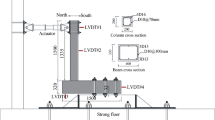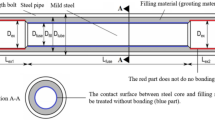Abstract
In laterally loaded connections, inclined installation of self-tapping screws (STS) allows for axial load transfer and significantly higher connection capacity and stiffness. In such a configuration, both the withdrawal and embedment resistances of the screw contribute to the overall load-carrying capacity and stiffness. To account for the contribution of the embedment component, embedment strength of the screw appropriate for the insertion angle is required. In this study, embedment tests were conducted to determine the influence of STS diameter, insertion angle and fastener thread on embedment properties. Using specimens of Douglas fir, a total of 164 embedment tests with 40 different configurations were conducted and analyzed. Test results showed that embedment strength, stiffness, failure mode and yield load are strongly influenced by the insertion angle, whereas the influence of STS thread and diameter is less apparent. These results were compared with those from another study and the feasibility of a model accounting for inclined insertion angles was analyzed.








Similar content being viewed by others
References
ASTM (2018) ASTM D5764-97a: standard test method for evaluating dowel-bearing strength of wood and wood-based products. ASTM International, West Conshohocken
Bejtka I (2005) Reinforcements of structural wood elements with fully threaded screws. PhD Dissertation, Karlsruhe University, Karlsruhe
CEN (2004) Eurocode 5: Design of timber structures. European Committee for Standardization, Brussels
Chui YH, Smith I, Chen Z (2006) Influence of fastener size on lateral strength of steel-to-wood screw joints. For Prod J 56:49–54
Clouston P (1995) The Tsai-Wu strength theory for Douglas-Fir Laminated Veneer. PhD Dissertation, University of British Columbia, Vancouver
CSA (2019) CSA O86-19 Engineering Design in Wood. Canadian Standards Association, Toronto
Dietsch P, Brandner R (2015) Self-tapping screws and threaded rods as reinforcement structural timber elements–a state-of-the-art report. Constr Build Mater 97:78–79. https://doi.org/10.1016/j.conbuildmat.2015.04.028
Franke S, Magnière N (2014) Discussion of testing and evaluation methods for the embedment behaviour of connections. Proceedings of International Network on Timber Engineering Research, Bath
Goodman J, Bodig J (1971) Orthotropic beams under normal and shear loading. J Eng Mech 4:83–94
Johansen KW (1949) Theory of timber connections. International Association for Bridge and Structural Engineering 9:249–262
Kennedy S, Salenikovich A, Muñoz W, Mohammad M, Sattler D (2014) Design equations for embedment strength of wood for threaded fasteners in the Canadian timber design code. Proceedings of World Conference on Timber Engineering, Quebec City
Michael A (2008) Connections in timber structures. Frederick Institute of Technology, Nicosia
Mirdad MAH, Chui YH (2019) Load-slip performance of mass timber panel-concrete (MTPC) composite connection with Self-tapping screws and insulation layer. Constr Build Mater 213:698–708. https://doi.org/10.1016/j.conbuildmat.2019.04.117
Mirdad MAH, Chui YH (2020) Stiffness prediction of mass timber panel-concrete (MTPC) composite connection with inclined screws and a gap. Eng Struct. https://doi.org/10.1016/j.engstruct.2020.110215
Pirnbacher, G, Brandner R, Schickhofer G (2009) Base Parameters of Self-Tapping Screws. Proceedings of CIB W18-Timber Structures, Duebendorf
Reynolds T, Harris R, Chang WS (2013) An analytical model for the dynamic stiffness of a dowel in timber under cyclic load. Eur J Wood Prod 71:609–622. https://doi.org/10.1007/s00107-013-0716-1
Ringhofer A, Brandner R, Schickhofer G (2015) Withdrawal resistance of self-tapping screws in unidirectional and orthogonal layered timber products. Mater Struct 48:1435–1447. https://doi.org/10.1617/s11527-013-0244-9
Ringhofer A, Augustin M, Schickhofer G (2019) Basic steel properties of self-tapping screws exposed to cyclic axial loading. Constr Build Mater 211:207–216. https://doi.org/10.1016/j.conbuildmat.2019.03.200
Risbrudt C, Ritter M, Wegner T (2010) Wood Handbook - Wood as an engineering material (Gen Tech Rep FPL-GTR-190). US Dept. of Agriculture, Forest Service, Forest Products Laboratory, Madison
Rothoblaas (2019) VGS. https://www.rothoblaas.com/products/fastening/screws/screws-structures/vgs#specs. Accessed Feb 20 2020
Rowse RC (1923) The strength of Douglas-Fir in compression at various angles to the grain. Washington University, St. Louis
Sawata K, Yasumura M (2002) Determination of embedding strength of wood for dowel-type fasteners. Jpn Wood Res Soc 48:138–146. https://doi.org/10.1007/BF00767291
MTC Solutions (2019) ASSY VG CSK. https://mtcsolutions.com/product/assy-vg-csk-counter-sunk-head/. Accessed Feb 20 2020
Whale LRJ, Smith I, Larsen HJ (1987) Design of nailed and bolted joints. Proposal for the revision of existing formulae in draft Eurocode 5 and the CIB code. Proceedings of CIB-W18A meeting, Dublin
Wilkinson TL (1991) Dowel bearing strength. USDA Forest Service, Forest Products Laboratory, Madison
Acknowledgements
The authors would like to thank the Natural Sciences and Engineering Research Council of Canada (NSERC) for the financial support of this study under the Industrial Research Chair (IRCPJ515081-16) and Undergraduate Summer Research Award (USRA-540864-2019) programs. Financial support was also provided by Landmark Group of Companies, FPInnovations, Canadian Wood Council, MTC Solutions, Rothoblaas, Western Archrib, Pinkwood Ltd and Alberta Innovates. In addition, MTC Solutions and Rothoblaas provided STS, and Western Archrib provided timber material for the test program. Their contributions are gratefully acknowledged.
Author information
Authors and Affiliations
Corresponding author
Ethics declarations
Conflict of interest
The authors declare that they have no known competing financial interests or personal relationships that could have appeared to influence the work reported in this paper.
Additional information
Publisher's Note
Springer Nature remains neutral with regard to jurisdictional claims in published maps and institutional affiliations.
Rights and permissions
About this article
Cite this article
Khan, R., Niederwestberg, J. & Chui, YH. Influence of insertion angle, diameter and thread on embedment properties of self-tapping screws. Eur. J. Wood Prod. 79, 707–718 (2021). https://doi.org/10.1007/s00107-020-01651-5
Received:
Accepted:
Published:
Issue Date:
DOI: https://doi.org/10.1007/s00107-020-01651-5




